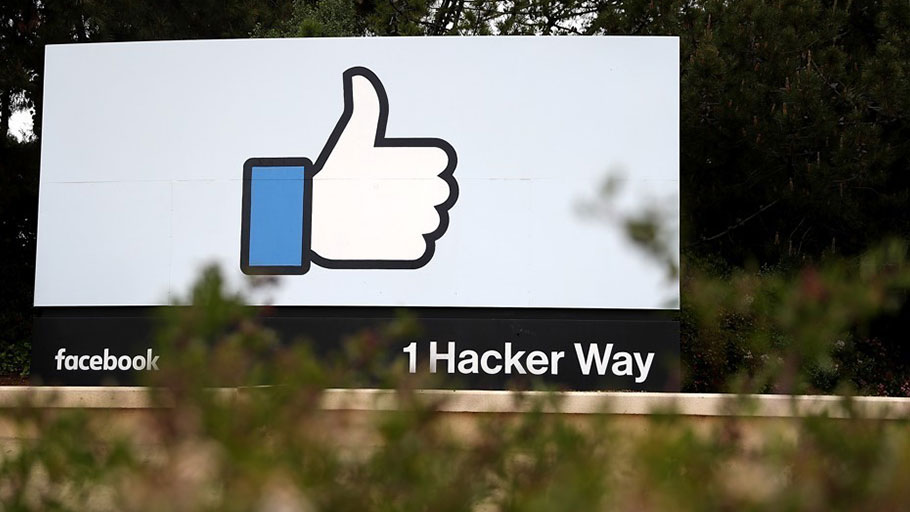A sign outside Facebook headquarters in Menlo Park, California, during an April 5, 2018 demonstration staged by activist group ‘Raging Grannies’ Justin Sullivan / Getty
Even in a high-tech era, fears about minority political agency are the most reliable way to destabilize the U.S. political system.
There are a million and one threads to the chaos currently unspooling about the Trump administration and the 2016 election. One might be forgiven for giving up on trying to navigate the intricacies of congressional Russia inquiries, Special Counsel Robert Mueller’s ever-widening probe, news about foreign intrusions into voting systems, investigations about Twitter bots, and the developing story about the manipulation of Facebook data. There are just too many details, too many variables, too many actors, and a hard limit to the amount of nihilism about what really happened in 2016 that can be absorbed with the steady onslaught of updates.
But there’s one main thread running through all of these stories, one that should orient readers to the things that truly matter, whether the news is about Cambridge Analytica or the Russian “troll farm” known as the Internet Research Agency. It’s the fact that the human brain is eminently exploitable—as are, by extension, the civic and democratic institutions the human brain has built. And in America, a country built from its foundations on white supremacy, where identity is forged in the crucible of a centuries-old “race question,” one of the easiest and most effective ways to “hack” those institutions is the use of racism in disinformation and propaganda campaigns. Almost every single American era of widespread racial friction was buttressed by sophisticated psychological manipulation, data gathering, and propaganda, a concoction that when taken together, often helped push whites to the extremes of anti-democratic oppression and violence. It’s the oldest American trick in the book.
That vulnerability is on full display in the ongoing Cambridge Analytica scandal, after The New York Times and The Guardian released investigations featuring allegations from whistleblower Chris Wylie that the firm harvested and exploited Facebook data in the service of conservative campaigns, including Brexit in the U.K. and Donald Trump’s 2016 campaign in the United States. There are lots of floating variables to this particular story—whether the data manipulation counts as an actual breach or an action enabled by Facebook’s own policy, what online privacy really means, the deteriorating public trust in Facebook, and even whether or not the tactics actually helped Trump win—but one vital detail is the seemingly critical role of racial foment in Cambridge Analytica’s electoral work.
A report from The Washington Post details how Cambridge Analytica, owned by conservative mega-donor Robert Mercer and linked heavily to former White House chief strategist Stephen Bannon, began embarking on research to figure out how to mobilize white conservatives:
In focus groups arranged to test messages for the 2014 midterms, these voters responded to calls for building a new wall to block the entry of illegal immigrants, to reforms intended to ‘drain the swamp’ of Washington’s entrenched political community and to thinly veiled forms of racism toward African Americans called ‘race realism,’ [Wylie] recounted.
“Race realism” is a new-ish term describing an old intellectual—or anti-intellectual—tradition using pseudoscience in the pursuit of racial dominance. It’s a new label for what’s now referred to as “scientific racism,” or research in social science, biology, and philosophy dedicated to proving the scientific inferiority of black people and other minorities, and thus validating white racial hegemony. Scientific racism—from the earliest anthropology to the quackery of phrenology to the ongoing appeal of eugenics—became the justification for white-supremacist and herrenvolk governments the world over, including Jim Crow America, the Third Reich, and South African apartheid.
Along with Cambridge Analytica’s psychometrics, the Internet Research Agency’s alleged actions were part of a set of schemes designed to leverage both the wealth of data in social media, and to use that data to exploit and manipulate people via the lever of racism.
The extent of the usefulness to the Trump campaign of these specific initiatives is still in question, but the strength of racist appeals should not be discounted out of hand. Propaganda and fear-mongering can be catalysts for underlying racist sentiment, either by confirming deeply held suspicions or encouraging others to edge past rhetorical boundaries—such as, say, prohibitions against violence, or the defense of American democracy. Such catalysts lower the activation energy for extremism. Underlying tensions and racial prejudices provide ample kindling, and a spark might not require much effort.
Like phrenology and “racialism” before it, “race realism” is a clever term designed to provide an intellectual sheen to the most base racist instincts. As such, it has a critical importance in the alt-right movement’s search for mainstream validation. Jared Taylor describes its importance in the mission statement of his far-right website American Renaissance:
Race is an important aspect of individual and group identity. Of all the fault lines that divide society—language, religion, class, ideology—it is the most prominent and divisive. Race and racial conflict are at the heart of some of the most serious challenges the Western World faces in the 21st century.
The problems of race cannot be solved without adequate understanding. Attempts to gloss over the significance of race or even to deny its reality only make problems worse. Progress requires the study of all aspects of race, whether historical, cultural, or biological. This approach is known as race realism.
The very fact that Cambridge Analytica’s researchers stumbled upon and tested the effectiveness of “race realism” in Facebook campaigns is alarming, but it doesn’t stand alone. The president’s campaign also employed race-baiting rhetoric. Until recently, Breitbart—a site formerly run by Trump’s one-time campaign CEO and chief strategist—maintained a “Black Crime” story category. The use of racist propaganda is a startling echo of the past and could be a blueprint for the future. Such propaganda has been used before to radicalize and mobilize Americans, in opposition to the rule of law, and even in opposition to democracy.
Propaganda and hoaxes involving threats of violence and seizures of power by people of color were critical in shaping the early American state, in consolidating power over enslaved people, and in spurring the Civil War. As the historian Robert Parkinson has argued, they were even wielded rather liberally by the Founding Fathers. While serving as the American ambassador to France during the waning days of the Revolution in 1782, Benjamin Franklin conjured up an entire fake issue of the Independent Chronicle, which included a hoax about American Indian allies of King George scalping hundreds of white Americans, with the hope “to send these Scalps over the Water to the great King, that he may regard them and be refreshed.” He presented the work as a genuine article, and it subsequently popped up in real newspapers, presented as real news. A month later, Franklin boasted that “it is not only right to strike while the Iron is hot, but that it is very practicable to heat it by continual Striking.”
While Franklin’s propaganda was intended to demonize the British government in the eyes of the British people—and make it more susceptible to yield to pro-American terms at the close of the war—his fake news was later weaponized to rally white Americans against Native Americans. During the War of 1812, which is itself a part of the larger American Indian Wars, the imaginary mass scalping was invoked by several newspapers after Pottawatomi warriors and British forces annihilated a contingent of Kentuckian fighters. While the remainder of that war is remembered as a relatively minor series of engagements with few overall British and American casualties, 10,000 indigenous Americans died in the fighting, and it helped spark a long series of atrocities in the West against hundreds of tribes. Stories like those fabricated by Franklin helped prime white settlers for that violence.
The following eras would see numerous slanders, hoax plots blamed on both African Americans and Native Americans, and regular rumors of slave rebellions invoked in a continual process of consolidating both property and power for white hegemony. Indeed, as Terry Ann Knopf argues in Rumors, Race, and Riots, fake stories about slave rebellions inflamed pro-secessionist thought in the South. The common theme is one that newspaper editors and demagogues alike used repeatedly to their advantage: White citizens were uniquely susceptible to perceived threats to their power, both nonviolent and violent, and often responded by further suspending democracy.
This proclivity manifested in a frequent and bloody fashion after the Civil War. Over the three decades following the end of that conflict, white paramilitary violence, lynchings, policing, and other anti-democratic political mechanisms were used in concert across the South in order to stop black people from voting; to institute forced apprenticeships, prison labor, sharecropping, and other forms of unfree labor; to erase all semblance of political, legal, and economic agency; and to implement in each southern state Jim Crow governments that lasted for generations.
That story is known—and told often in the pages of this magazine—but it’s the specific ways in which white supremacists engaged in widespread radicalization of poor whites that seems particularly relevant today. Redeemers like the North Carolina Democratic leader Furnifold Simmons recruited poor whites into their political coalitions by using fear-mongering about rape of white women by black men, and about the prospect of “Negro rule.” Scientific racism was critical in establishing the pretext for barring black people from democratic participation, and for inspiring them to ever more violent methods.
Simmons often receives top billing in North Carolina for the establishment of a near-century of white supremacy. But, as was the case in other states, he benefited from a well-oiled psychological-warfare machine. The leader of the information experiment undergirding Simmons’s campaign was Josephus Daniels, editor of the Raleigh News and Observer, and a man who strikes an eerily similar figure to some principals in the Cambridge Analytica story.
According to an exhaustive report on the grand finale in Simmons’s and Daniels’s white supremacy campaign, the 1898 Wilmington Massacre:
Using the News and Observer first as a barometer of public opinion and then as a weapon, Daniels and Simmons worked together to develop a strong argument against Fusion and in favor of white supremacy in order to win the 1898 election. The paper slowly introduced the white supremacy issue to its readers, fed stories to other papers, and worked the reading public into a frightened and tense frenzy … [Daniels] bragged that, because of the print campaign, ‘people on every side were at such a key of fighting and hate that the Democrats would believe almost any piece of rascality.’
Daniels used his paper as a primitive data-collection tool, gauging the sensibilities and vulnerabilities of his white readers, and then took those data and weaponized them, feeding a precise mixture of fact, fiction, pseudoscience, inflammatory arguments, and meme-like cartoons to the minds of men that Simmons considered would-be “riders.” Those riders then conspired to suspend democracy, killing or intimidating the black people who got in the way.
But even with white supremacy established, as Knopf details, disinformation and propaganda were used to solidify the authoritarian anti-black state, and to disrupt potential loci of minority political and economic power. These efforts were especially effective during the domestic labor and integration tensions of World War I, and led to race riots and mass lynchings throughout the country. In East St. Louis, a series of white assaults against black people in 1917 left dozens dead.
Knopf writes about how “widespread stories maintained that blacks were forcing whites from their neighborhoods, that they were planning to assault white women, and that employers were to blame for the influx of blacks.”
This sort of racially inflammatory rhetoric lay behind the two major riots, and newspapers were perhaps the most active participants in sowing the seeds of carnage. After a black family reported that a car full of white citizens shot into their home on July 1, a police squad car was sent—in the same make of car as the shooters had used—to investigate, and the aggrieved family shot and killed two officers in the resulting confusion. The next day, the St. Louis Republic—with no evidence whatsoever—ran a story alleging that the killings were planned, a story that provoked the violence of July 2. Two days after that episode, the Republic continued its breathless defense of the pogrom, running a headline stating that “25,000 Whites Were ‘Doomed’ in Negro Murder Plot.” In their account, white violence had been a reaction to the formation of a thousands-strong “army” of black people, one that sought to assassinate prominent white citizens and establish control of the city. None of that was true.
Similar white mob violence erupted across the country through the early 20s, corresponding with a rise in Ku Klux Klan activity—and with a rise in racist propaganda. Similar disinformation was critical in multiple race riots during the “Red Summer,” in which nearly 1,000 black people were killed. In every instance, white supremacists easily exploited the racial fears of white laborers, often with the gleeful aid of media allies, and further eroded democracy. And in so doing, they created a precedent that would prove mighty useful for anti-democratic actors today, whether they be domestic or foreign.
The indictment filed in February by special counsel Robert Mueller against 13 Russian nationals working for the Internet Research Agency illustrates how the Kremlin was interested in exploiting racial tensions on Trump’s behalf. Mueller charges that the group created a far-reaching network of fraudulent or automated social-media accounts that spread disinformation and sowed discord during the 2016 election cycle. One central tactic appeared to be cribbed directly from the Jim Crow playbook: using both racist messaging against black people and fake black activism to amplify polarization and the likelihood of political violence.
The indictment offers some interesting details on the actual strategy employed. One prong of the trident involved utilizing fake black-radical accounts on Instagram and Twitter like “Woke Blacks” and “Blacktivist,” as well as similar accounts purporting to represent Muslims and immigrants, to encourage people of color to disengage from voting. The second prong in the racial strategy was disseminating false information about voter fraud or the potential of voter fraud, delivered by fake conservative accounts to conservative users. The third was racist fear-mongering, sometimes using the fake tweets from the first prong and reaction to them as fodder.
Implicit in all of these methods was the threat of violence, both from the fake black accounts and from conservative accounts. The “Blacktivist” account suggested retaliation against police officers for brutality. The “Being Patriotic” Facebook group—one with over 200,000 followers before it was shuttered—encouraged shooting people who protest the American flag. Additionally, fraudulent accounts made threats of voter intimidation, especially against immigrants, around the time of the election.
As my colleague Alexis Madrigal writes, these tactics weren’t exactly the stuff of cutting-edge social-media engagement, and neither Russian bots, dark Facebook ads, nor data mining likely seriously affected the majority of voters. Especially when viewed from a perspective with a broad view of the infinite moving pieces of scandal, foreign influence, technology, social media, partisan politics, dark money, and media conduct that all appear to have deeply mattered to the outcome of the 2016 election, it’s important to be skeptical of overly deterministic conclusions about how much of a difference any of this made. But, if there’s anything to be learned from the politics of the past few decades, it’s that the margins of American democracy are often razor thin. And racism is a tried and true way to work those margins to political advantage.
Take, for example, the Internet Research Agency’s strategy involving using imposter accounts designed to look like real black, Latino, and Muslim activists. Ostensibly, their exhortations for people of color to disengage from politics, and even perhaps engage in violence are directed at those people of color. But based on how skeptically black online communities have reacted to similar online infiltration tactics in the past, and the history of American white backlash to activism by people of color, the creation of fake accounts of people of color appears mostly designed to agitate white-supremacist sentiments. As Black Lives Matter Oakland activist Malkia Cyril told Blavity: “Whether they appear to be in support or in opposition to black civil rights is irrelevant. Their aim is to subvert democracy for everyone by using anti-black stereotypes—an idea as old as America.”
Cyril’s assessment resonates. The strategy of using racism to steamroll democracy is older than America. And as the history of the American experiment shows, this particular strategy doesn’t need masterminds or even competent people in order to pull it off. It just needs the background noise of racism and racial anxiety, along with people devious enough to exploit them. What the Cambridge Analytica and Internet Research Agency sagas indicate is that this original weakness in American democracy persists, while the technology and ability to exploit it only seem to advance.















